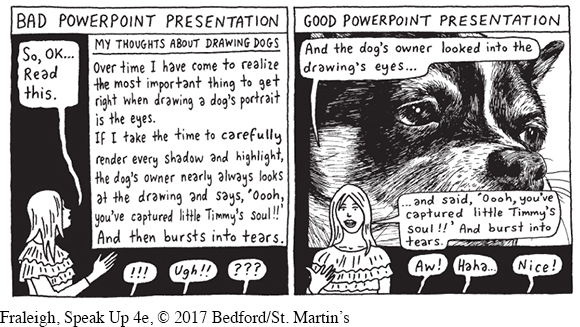Using Presentation Software
Presentation software (sometimes referred to as slideware) enables users to create, edit, and present information, usually in a slide-
The most commonly used presentation software is Microsoft PowerPoint,7 but other software products are also available, including Adobe Flash, Apple Keynote, Articulate Presenter, Camtasia, Camstudio, ClearSlide (SlideRocket), CustomShow, Emaze, GoAnimate, Google Docs Presentations, Haiku Deck, Knowledge Vision, MediaShout, OpenOffice Impress, Projeqt, Powtoon, Prezi, Reallusion, Slide Bureau, SlideDog, Slideshare, Slideshark, Snagit, Wink, and Zoho Show.8 The instructions for using these programs vary and change with each new version (refer to your program’s user guide for technical guidance). Along with the general guidelines for any presentation aid, there are certain things you should keep in mind when developing a digital slide-
Use it to unify a mixed-
Remember, content is king. Don’t let your speech be eclipsed by technological bells and whistles. As with any presentation aid, you should use presentation software to share material that supports your points. A slick digital presentation that lacks substance might look good, but it is unlikely to impress your audience (or your instructor). Your speech should be solid enough to deliver without any aids at all.
Page 417

Don’t let the software steal the show. Presentation software should be used to assist you in delivering your speech: it shouldn’t deliver your speech for you. Remember that you need to be the center of attention, not your slides. Help your listeners focus on you and your message: avoid reading from your slides, move around as you speak, maintain eye contact with listeners, and limit the amount of text in your slides. Use your slides to show material; use your speech to talk about the material you show.